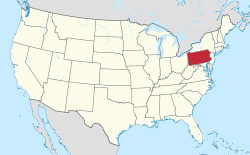Waverly Township, Pennsylvania
Waverly Township
Abington Township | |
|---|---|
 Waverly Community Church, located on Clinton St. (PA 632) | |
 Location of Pennsylvania in the United States | |
| Coordinates: 41°31′00″N 75°41′59″W / 41.51667°N 75.69972°W | |
| Country | United States |
| State | Pennsylvania |
| County | Lackawanna |
| Area | |
| • Total | 4.56 sq mi (11.81 km2) |
| • Land | 4.55 sq mi (11.79 km2) |
| • Water | 0.01 sq mi (0.02 km2) |
| Elevation | 1,217 ft (371 m) |
| Population | 1,743 |
| • Estimate (2016)[3] | 1,705 |
| • Density | 374.56/sq mi (144.60/km2) |
| Time zone | UTC-5 (EST) |
| • Summer (DST) | UTC-4 (EDT) |
| Area code | 570 |
| FIPS code | 42-069-81668 |
| Website | www |
Waverly Township is a township in Lackawanna County, Pennsylvania, United States. It is bordered by Dalton and Glenburn township to the west, North Abington Township to the north, the boroughs of Clarks Summit and Clarks Green to the south, and South Abington Township to the south and southeast. Waverly Township is part of the growing suburban area known as the "Abingtons". The population was 1,743 at the 2010 census.
Prior to 2011, the township was named Abington Township, and was originally referred to as "Ebbington" in Connecticut's claim in 1806.[4]
History
Waverly was founded in the late 18th century by settlers from Connecticut, along the Warriors' Path, and was originally called "Abington Center". In 1853, it was established as a borough within Pennsylvania and renamed "Waverly" after Sir Walter Scott's novel of the same name, popular at that time. It was renamed because there was another municipality named Abington located near Philadelphia. The borough, located within Lackawanna County, gave up its charter in 1920 due to the high cost of upgrading its main street to a state highway, and became Abington Township.
The Philadelphia and Great Bend Turnpike (now Main Street) was chartered in 1919 by the Pennsylvania Legislature along the Warriors' Path. Started in 1820, the turnpike was completed in 1824. In 1828 the Wayside Inn was built, and the first doctor, Andrew Bedford, set up practice and built a house which stands today on Main Street. The first general store was built in 1830, followed by a second inn and tavern in 1832. A building boom ensued during the years 1847 through 1890, during which time Waverly was a profitable small-scale industrial center.
During the mid-19th century, Waverly was a stop on the Underground Railroad. Escaped slaves and freedmen found a sympathetic population in Waverly, and some settled in small houses built by a local farmer and sold to them. The freedmen also built the AME Church, which is in use today as a private residence. It is one of five churches in existence in 1872, three of which still stand and are still active congregations.
Due to confusion between the Montgomery County township and Lacakwanna County's North, South, and West Abington townships, township officials set up a ballot initiative to rename the municipality to Waverly based on one of its former names. On November 2, 2010, voters in the township overwhelmingly voted to change the township's name to Waverly Township, with 706 voting for the change and 115 against. The name change officially took place on January 1, 2011.[5][6]
The Waverly Historic District was added to the National Register of Historic Places in 2004.[7]
Fire in 1916
In the spring of 1916, a fire devastated the four downtown blocks of Waverly; only 11 businesses remained thereafter. Of those, two buildings have operating businesses in them today: The Waverly Deli and The Waverly General Store. The front two blocks were an eyesore, although summer visitors continued to come from Scranton to Waverly. The Belin Family bought the front two blocks and began design and construction of the Waverly Community House. The building was completed in 1920, and expanded to the back two blocks of the original downtown; all streets through those blocks had been removed, and the transformation of downtown to picturesque center was complete.

The Community House (commonly referred to as "The Comm") sits at the center of Waverly. The brick Dutch colonial structure currently houses the Waverly Post Office, a gymnasium with basketball court, a public playground, a preschool program and numerous recreational and educational offerings for families with young children. The Comm also plays host to an annual home and garden show, antique fair, and concerts on the lawn. Margaretta E. Belin funded construction of The Comm as a memorial to her husband, Henry Belin Jr., after his death in 1917. On June 4, 1920, the building and a portion of the land were deeded to Abington Township for the benefit of the township's residents. Wealthy summer visitors from Scranton migrated to Waverly on a permanent basis, and the town's reputation as a white-collar bedroom community was cemented.
Geography
According to the United States Census Bureau, the township has a total area of 4.6 square miles (11.8 km2), of which 0.01 square miles (0.02 km2), or 0.17%, are water.[1]
The central part of the township comprises the Waverly census-designated place.
Demographics
| Census | Pop. | Note | %± |
|---|---|---|---|
| 2010 | 1,743 | — | |
| 2016 (est.) | 1,705 | [3] | −2.2% |
| U.S. Decennial Census[8] | |||
As of the census[9] of 2010, there were 1,743 people, 639 households, and 515 families residing in the township. The population density was 378.9 people per square mile (146.3/km2). There were 686 housing units at an average density of 149.1/sq mi (58.2/km2). The racial makeup of the township was 94.5% White, 0.2% African American, 3.8% Asian, 0.3% some other race, and 1.1% from two or more races. Hispanic or Latino of any race were 2.5% of the population.
There were 639 households, out of which 34.1% had children under the age of 18 living with them, 70.1% were married couples living together, 7.5% had a female householder with no husband present, and 19.4% were non-families. 16.3% of all households were made up of individuals, and 8.5% had someone living alone who was 65 years of age or older. The average household size was 2.72 and the average family size was 3.06.
In the township the population was spread out, with 25.8% under the age of 18, 57.2% from 18 to 64, and 17% who were 65 years of age or older. The median age was 45.9 years.
The median income for a household in the township was $122,222, and the median income for a family was $150,221. Males had a median income of $98,036 versus $43,958 for females. The per capita income for the township was $52,653. About 2.9% of families and 3.4% of the population were below the poverty line, including 1.4% of those under age 18 and 3.3% of those age 65 or over.
Education
The first school was started in his log cabin in 1804 by Elder Miller, the first settler in the town. The first dedicated school was built in 1830 on the Philadelphia and Great Bend Turnpike. After it ceased being used as a school, it became a private residence for many years; the Waverly Historic Society is currently planning for its renovation and use as their headquarters. In 1844, a group of investors started the Madison Academy. This was a private school which enjoyed high regard and taught a rigorous curriculum to boys and girls. Students came from all over Pennsylvania to attend the Madison Academy; some of its graduates became judges and attorneys. The tuition ranged from $2.00 to $10.00 per quarter, depending upon the grade, and the boarding house next door charged $1.25 to $1.50 per week. Following the closing of the private school in 1878, the building was used as a public school through 1925, at which time it was razed. The Belin family donated a new school building to the town that originally served all grades. The site of that school is now occupied a newer building, Waverly Elementary School, which serves Kindergarten through fourth grade and is part of the Abington Heights School District. This is currently the only public school in the township, and is where all of the elementary students in the township attend school.
The bell from the Madison Academy hangs behind Waverly Elementary, a testament to the long tradition of academic excellence in Waverly. Although the academy was razed, the house across the street from it has a bell in its attic, and is sometimes mistaken for the original Madison Academy.
All middle school students residing in Waverly Township attend Abington Heights Middle School, and high school students attend Abington Heights High School.
See also
- Waverly, Pennsylvania - A census-designated place within the township
References
- ^ a b "2016 U.S. Gazetteer Files". United States Census Bureau. Retrieved Aug 14, 2017.
- ^ "Total Population: 2010 Census DEC Summary File 1 (P1), Abington township, Lackawanna County, Pennsylvania". data.census.gov. U.S. Census Bureau. Retrieved August 31, 2020. - as "Abington Township"
- ^ a b "Population and Housing Unit Estimates". Retrieved June 9, 2017.
- ^ http://www.waverlytwp.com/historical-info/. Retrieved April 25, 2016.
{{cite web}}: Missing or empty|title=(help) - ^ Nissley, Erin L. (October 28, 2010). "Voters in Abington Twp. to decide on proposed name change". Scranton Times-Tribune. Retrieved October 25, 2015.
- ^ Nissley, Erin L. (November 3, 2010). "Abington changes name to Waverly". Scranton Times-Tribune. Retrieved October 25, 2015.
- ^ "National Register Information System". National Register of Historic Places. National Park Service. March 13, 2009.
- ^ "Census of Population and Housing". Census.gov. Retrieved June 4, 2016.
- ^ "U.S. Census website". United States Census Bureau. Retrieved 2011-05-14.
External links
 Media related to Waverly Township, Lackawanna County, Pennsylvania at Wikimedia Commons
Media related to Waverly Township, Lackawanna County, Pennsylvania at Wikimedia Commons- Official website
- The Comm, Waverly Community House

